Module 14: Hiring and Working with a Woodland Contractor
Module 14 - Lesson 2 - Woodland Roads: Vital Links for your Contractor
Well-constructed and maintained woodland roads are crucial for efficient movement of both wood and workers. Roads are also a vital safety link should incidents occur when quick transport to and from work sites is needed. For this reason, you should pay particular attention to the condition of your roads.
If wood is to be transported from your woodland site to a mill or wood yard, you will likely need a road. New roads can be built where none have existed before, or old roads and trails can be upgraded to meet the requirements of logging trucks. If you already have a woodland access road, ensure it is adequate to accommodate modern semi-trailers. Pay particular attention to the width of the entrance at the main road, and the size of the turnarounds (if needed). While some truckers are willing to back their vehicles a short distance, others are not. You should also be aware that a permit from the Nova Scotia Department of Transportation and Infrastructure Renewal is required to construct a new road entrance.
 |
| Good woodland roads are vital links for contractors. |
Road requirements should be thoroughly discussed with your harvesting or silviculture contractor. Ensure the road meets the contractor’s needs. If road upgrading needs to be done prior to the contractor beginning work, clarify who will bear the cost of this work. Also discuss the possibility the road may deteriorate through use, or while the contractor is using it, and reach an agreement on who is responsible for maintaining the road in a trafficable condition. For your own protection, it may be advisable to take photos of your road, particularly if it is new, which can help in avoiding disputes over the original condition of the road.
To keep costs down, it may be a good time to think about excavating one or more ponds while the road-building equipment is on site. Ponds can be real hotspots for wildlife and also provide a measure of safety when dealing with potential forest fires.
An Ounce of Prevention
Heavy forestry equipment can easily damage the surface of a woodland road during wet seasons of the year of if the road is relatively new. Forwarders (porters) loaded with wood should avoid travelling on roads which are to be used for trucking. In many cases, wood can be piled at roadside from the back (off-road) side, so that road damage is avoided. If road damage from equipment is a concern, mention it to the harvesting contractor.
Keep in mind that woodland harvests can greatly increase water runoff from a site. Ensure the road ditches and culverts can handle increased peak flowage. Knowledgeable contractors will recommend replacement of inadequate or damaged culverts, and will keep an eye out for potential ditch blockages and culvert obstructions. If culvert or bridge work is required on watercourses, make sure qualified personnel supervise the work, including individuals which are certified in watercourse alteration. A little extra caution can go a long way towards preventing unnecessary damage!
 |
| Proper road construction is a key element in woodland stewardship. |
For advice and information on woodland road funding assistance, contact Forest Products Association of Nova Scotia, whose contact details are found in the Additional Resources section of this module.
Crossing Other Properties
It is sometimes necessary to cross a neighbouring property to access some areas of your woodland.
If this is the case, an agreement between yourself and the owner of the property should be arranged. As with all contracts, it is preferable to have an agreement in writing, rather than verbal consent.
Temporary rights-of-way are fairly common in forestry operations. Often a contractor will prove to be valuable in gaining permission to cross neighbouring property if he or she has a solid reputation for fairness and good quality work. If a contractor indicates he already has permission to cross adjoining land, ask to see the signed agreement.
Absentee landowners can be difficult to contact when permission is sought to cross their land. Every attempt should be made to speak with them directly, or to an agent who may be handling their affairs. If language is a barrier and there is no local agent, it may be best to contact a lawyer who will ensure that contact is made.
Rights-of-Way
If wood is to be extracted over neighbouring land, you or the contractor should make it clear to the owner any damage to their property will be repaired. This should be indicated in the right- of-way agreement. If, in your contract with your forestry contractor, he is held responsible for repair work, the contractor will go to extra lengths to prevent damage from occurring in the first place.
In some instances – and if it is in his interests – the contractor may be able to access future work on the neighbouring property, further benefitting all parties.
The actual right-of-way should be clearly marked with flagging tape, to avoid misunderstandings about its location. If trees must be harvested to clear a right-of-way, a fair stumpage value should be paid to the neighbouring woodland owner.
In some instances woodland owners may wish to be paid an access fee that is over and above the stumpage value of the wood harvested from a right-of-way. This fee might be demanded to cover the lost potential revenue of immature trees which are cleared from the right-of-way, or may simply be payment for access. It is important to discuss the benefits and disadvantages of all aspects of a right-of-way with your contractor.
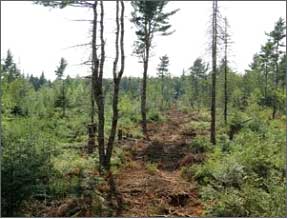 |
| Any right-of-way crossing an adjacent property should be described in a written agreement. |
Reducing Your Risks
Once you have located one or more woodland contractors who appear to suit your needs, you should ask for credentials which prove a contractor’s level of capability. Accessing funding assistance for silviculture or road construction may require credentials. Such credentials can include, but are not limited to:
- Forest professionals, including Certified Forest Technicians and Registered Professional Foresters
- Forestry training, including silviculture training;
- Nova Scotia’s Forest Ecosystem Classification training;
- Certification, including Atlantic Master Logger certification
- First aid training;
- WHMIS training;
- Watercourse alteration certification;
- Letter of Good standing with Workers Compensation Board of Nova Scotia; and
- Any other training or certification which increases your confidence in the contractor’s ability to deliver excellent forestry work
You should not feel pressured to carry out forestry work that is different from or not recommended in your woodland stewardship plan. If a contractor is adamant extra work should be done, or your plan should be changed, you should ask for another opinion. A forest professional should be able to give you his or her objective opinion.
Get it in Writing
Congratulations! You’ve found the right contractor, but now what? One of the first things you should do - no matter how sincere a contractor may appear - is take steps to reduce your risks of loss due to property damage or personal injury. This can be accomplished through the use of a contract, which is a legally binding obligation to perform to a defined level of expectation. The contract is binding upon both the landowner and the contractor.
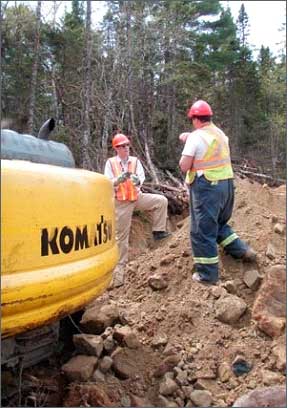 |
| It is important to have a legally binding contract in place before work begins. |
The Contract: the Core of Your Contractor Relationship
When you are working with a contractor, no other instrument is as effective as a rigorous and thorough contract. By setting out the responsibilities of each party, a well-written contract will protect both yourself and the contractor from anticipated and even unanticipated events and results.
Many contracts are made verbally, but it is much better to go the extra step and have a written contract. It is also advisable to have a third-party witness who is aware of the details of the contract.
A good contract will contain the following information:
1. Details of Job:
The job itself can be described by:
- Area, if it is silviculture or harvesting work.
- For example, the area could be 10 hectares (25 acres) in size.
- Treatment description. For example, the treatment may be selection harvesting, or clear-cutting, or shelterwood.
- Boundaries. For example, the job may be bounded by a stream, boundary line or road.
There may be other preferences or limiting factors, examples being:
- Leaving firewood standing for owner’s personal use;
- Closing of road gate each night;
- Harvesting only balsam fir, leaving all red spruce standing, if not interfering with operation;
- Removing all harvested wood from property by a certain date;
- Keeping road and landing clear of debris.
- Maintaining adequate fire equipment on site;
- Ecosystem-based management with pre- and post-treatment assessments;
- For absentee landowners, how the progress of the work will be communicated; and
- The type of equipment to be used in carrying out the job.
2. Details of Payments
- To contractor: if woodland owner is paying for silviculture treatments, road construction or other service
- To woodland owner: if contractor is paying for standing wood (stumpage)
The contract should also indicate how the payments will be made (through bank account, cheque or other means) and how often payments will be made. For instance, wood payment may be made: (a) as a lump-sum up front, (b) as the wood is sold within a specified time limit or (c) at regular intervals – for instance, every two weeks or every month. There may be other methods of payment which are acceptable to both parties.
You should contact your accountant to determine the best payment option for your particular circumstance.
The payment should also indicate whether there are any additional check-offs or deductions, which may include the costs of planned future silviculture treatments or other expenses.
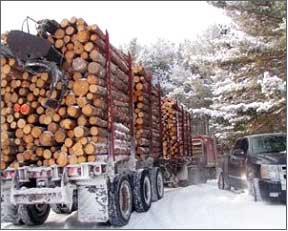 |
| Payment details for harvested wood should be carefully laid out in a contract. |
3. Responsibilities of Each Party
This section of the contract should outline the duties of the contractor and woodland owner. It should answer questions similar to the following:
- Who will repair the road if damaged?
- Who will look after the sale of the wood?
- Who will mark the operations area?
- Who will be responsible for follow-up treatments, including site regeneration such as tree planting?
4. How Any Potential Conflicts Will Be Resolved.
To be effective, a contract should be CLEAR, CONCISE and COMPREHENSIVE.
While unexpected results and events will occur, a contract will assist in solidifying the business relationship between yourself and the contractor.
See Appendix 1 for a sample harvesting contract. While this sample contract may seem basic, it could be a good foundation on which to build a more comprehensive, detailed contract.
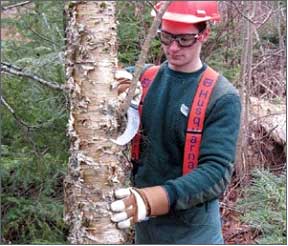 |
| All woodland stewardship work, including silviculture such as crop tree pruning, should be initiated by a contract. |
Insurance: Reducing Your Liability Risk
Most woodland contractors carry some insurance. This is an essential element of working on property which they do not own themselves. Adequate insurance is necessary to protect contractors and their employees, and it may also protect you as a landowner.
Workers Compensation Insurance
All persons working to earn an income in Nova Scotia must have Workers Compensation Insurance. This basic insurance can provide a worker with coverage should he or she be unable to continue working due to a workplace injury. Depending on the type of work being done, premium rates can vary greatly. It is very important you check with your contractor to ensure both the contractor and his or her workers have Workers Compensation Insurance. This will protect you from incurring expenses associated with workplace accidents on your woodland. It is a good idea to make it a condition of any contract the contractor carries this insurance, and for the proper class of work. You should ask the contractor for a copy of a Letter of Good Standing from the Workers Compensation Board of Nova Scotia, as proof the contractor’s premiums have been paid for the year. It should be noted that even if you are working on your own woodland you may require Workers Compensation insurance.
Public Liability and Property Damage Insurance
Whenever you cause damage to another person, or another person’s property, you may incur liability for damages. Public Liability Insurance helps protect you from consequent actions resulting from the damage.
It is not difficult to realize all contractors working on other persons’ properties should carry Public Liability and Property Damage Insurance. This insurance may provide coverage should a contractor accidentally harvest trees on an adjacent property, or cause damage to other properties through silt runoff, equipment fuel leaks or forest fire. It is important to specify the types of damage that a contractor’s insurance premium will cover, since not all Public Liability Insurance is the same. If you need more information, contact your insurance company. It is usually recommended that a specified minimum amount in coverage be carried by a woodland contractor. Your contract should indicate both the type and extent of coverage.
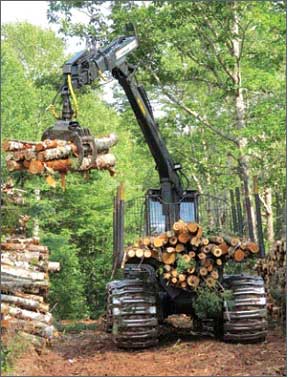 |
| Insurance coverage is a key component of a woodland stewardship contract. |
Due Diligence: Your Greatest Responsibility
No amount of insurance can replace common sense and due diligence. It is incumbent upon you, the woodland owner, to ensure the risks of injury are reduced for anyone working on or using your property. If, for example, you have not told your contractor about an old well you know is on the work site and is unmarked and uncovered, you may be liable if a worker becomes injured as a result of falling in or colliding with the well.
Woodland road gates can be particularly dangerous if they are not highly visible. Advance warning signs should be posted on the approaches to gates, and the gates should be brightly painted. Cable gates are difficult to make visible, and should not be used. Your contractor should be made aware of any gates on your woodland, and an agreement should be reached about who is responsible for opening and closing gates, particularly if the gates are to be locked.
Your chances of being sued for damages by a contractor may be greatly reduced by practicing due diligence of the kind noted above. In many instances it can be the result of simply employing common sense!
Closing the Deal
Work should only be started by the contractor once both parties have signed an agreed contract. There should be two original copies of the document: one for the contractor and one for you. It may be beneficial to have a lawyer or someone who is familiar with contracts to review the details before it is signed. You may wish to have a witness present when the signing is taking place.
When the Contract is Complete
Your contractor will indicate when he or she believes the job is complete. Review your contract to ensure all aspects of the contract have been met. If there are any outstanding issues, this may be your last chance to address them. Has all the wood been trucked? Is your road in good condition? Are all your blazed boundary line trees still in place? Is the site clear of garbage and debris?
If you are satisfied with your contractor’s performance and stumpage payments, be willing to provide a reference for them. This will ensure that good contractors have ample supplies of work in the future. Talk frankly with other woodland owners about your experiences with the contractor. If the contractor is a Certified Master Logger, you may be asked to describe your level of satisfaction with the quality of the job and with the contractor’s performance.
Checklists
Post Harvest
Roads
•Have the roads and landings been left in good condition, or repaired to your satisfaction?
• Are all culverts and ditches free from obstruction?
• Has all the wood been trucked from roadside?
• Are ditches free from rutting?
• Are roads and landings free of logging debris?
Site
• Have any and all oil or fuel spills been properly contained and cleaned up?
• Has all garbage (including oil containers) been removed from the site?
•Have all equipment and fuel tanks been removed from the site within a reasonable time frame?
• Has all significant rutting been repaired?
Post-silviculture
•Are access roads in good condition?
•Is the site free of garbage?
•Has the site been checked by a forest professional to ensure conformity with silviculture criteria and job quality standards?
•Has the contractor followed your instructions regarding leaving certain trees and areas untouched?
Whether your woodland site has been harvested, thinned in a silviculture operation or planted in trees, it is worthwhile to have a forest professional check the job to ensure all wildlife and watercourse protection regulations have been met.
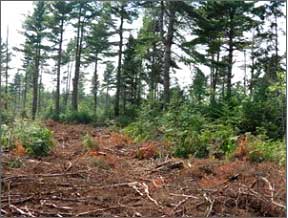 |
| A contract is complete only when all the signatories are satisfied that the contract conditions have been met. |
Conflict Resolution
Everyone usually hopes all details of a contract will be carried out satisfactorily, but there are often circumstances when this does not happen. Your contract should be the first tool for ensuring conflicts between yourself and a contractor are minimized. For this reason, contracts should be as detailed as possible.
In the rare event that things go wrong, it is often good to have a lawyer draft your contract – or at least be aware of its contents – should you require legal advice in a dispute. Of course, it is always preferable that a conflict should be settled amicably, and for this reason it is doubly important you obtain good references for your contractor, and you become familiar with his method of operations before he is hired.
If issues do arise, it is important you address them as soon as possible. This may involve halting the contractor’s work until the issue is resolved. Be aware, however, if wood has been harvested, a contractor may have recourse to be paid for harvesting work that has been completed.
Conclusion
Hiring and using a contractor can be both challenging and rewarding. It can also be the most progressive action you may take as a woodland owner. Contractors can accomplish tasks you may find difficult or impossible to do yourself. They usually have the expertise, experience and equipment needed to do the job well.
At the same time, everyone involved in managing your woodland should reduce the risks of property damage and personal injury. Even so, insurance is needed to verify you are covered should an event occur. For this reason, you should ensure both you and the contractor have sufficient insurance.
A clear, concise and comprehensive contract will outline the responsibilities of each party, so that everyone understands their roles in managing your woodland. Make a point of insisting a contract is the best way of guaranteeing a satisfactory outcome for everyone involved.
Finally, cherish your relationship with a contractor. Hiring a contractor may be the best action you have ever taken on the road to being an excellent steward of your woodland.
